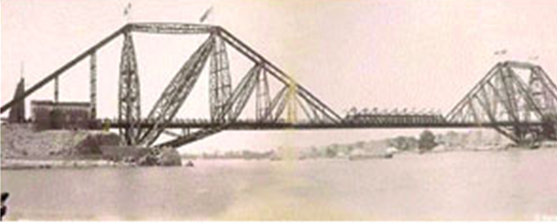Sukkur
This is a collection of articles archived for the excellence of their content. Readers will be able to edit existing articles and post new articles directly |
Sukkur
Great past; uncertain future
By Manzoor H. Kureishi
THE city of Sukkur is located on the bank of the mighty River Indus. It is one of the oldest human settlements in Sindh. On its opposite side is its twin city Rohri, close to Arore, Sindh's capital during medieval times. It is here that Mohammad bin Qassim defeated Raja Dahir. The Muslim general later built a mosque, the first in the subcontinent.
This mosque is now in an extremely poor condition and speaks volumes for the apathy of later generations towards the structure. The city of Rohri is located at the main railway junction connecting Sindh with Punjab and Balochistan.
The East India Company and the then British government put great emphasis on developing a communication network to strengthen their hold on the newly occupied territories. In order to connect upcountry with the rest of the province through railways, bridges were constructed over the River Indus at various crossings. The Lansdowne Bridge (named after Lord Lansdowne, the then Governor-General) was constructed in 1889. This bridge, weighing 30,300 tons and having a length of 820 metres, doesn't have any pillar. It is said that after the completion of the bridge no driver had the courage to take the train on it. However, a Habshi driver (descendent of Ethiopian slaves) who was in jail then, offered his services and drove the train. He later received many awards. In the '60s another bridge was constructed in the Ayoob era to reduce the burden on the age-old Lansdowne Bridge.
The British, taking into account Sindh's dire need for irrigation water, conceived in 1855 an irrigation network of enormous size over the River Indus in Sukkur. The construction of the world's great water-works started in 1925 at a hefty cost of rupees 200 million. They were completed on December 31, 1931. From this barrage originate seven canals covering areas ranging from 2.40 miles (Khairpur Feeder) to 131.1 miles (Dadu Canal), irrigating around 80 lac acres of barren land. The construction of the Sukkur Barrage revolutionised the entire Sindh.
Following completion of the above-mentioned two projects, Sukkur gained significance in the regional setup and a new city emerged. Because of the important railway junction at Rohri, the railways department built many remarkable edifices such as the Club a Hospital (1885) for workers of the Railways along with official residences and a school. Similarly, the Irrigation Department built a well planned modern residential colony for officers and staff on the bank of the River Indus.
The British near garam godi built an exquisite looking clock tower in 1885. In 1937 another beautiful 90-ft-high tower with four clocks was built by Seth Wadho Mal, a Hindu philanthropist and a businessman in memory of his two brothers, Sundar Das and Seth Devo Mal at a cost of rupees 10,000. On its eastern side a small park was also established adding to the beauty of the tower. Yet one more clock tower (Education Tower) was established in 1939 by Pir Illahi Bux, the then Minster of Education, who spearheaded a movement to mark the end of illiteracy in the province. Noteworthy educational institutions were also established in the region.
With enhanced economic activities and a better literacy rate, socio-cultural and educational activities gained momentum in the city. The institutions of note that came into existence in the new Sukkur produced many celebrities like Sheikh Ayaz, Fateh Malik, Dr Tanveer Abbasi, the Rashidi brothers, Afaq Ahmed Siddiqui, Rashid Bhatti, Rahimdad Khan Moulai Shedai (a locomotive drive-turned-historian) Naimtullah Qureshi, Dr Muhammad Omer Sheikh to name a few. Apart from that, renowned advocates like Abdul Sattar and Abdul Hafeez, Shamsuddin Shah, Khalid Ishaq (finally settled in Karachi), Fatehullah Usmani (migrated in 1947 but was more native than the natives) Qaimuddin Jatoi, Samandar Khan, Rukunddin Qasimi, and Agha Saddruddin earned fame in their respective professions.
Unfortunately after the fall of the Bhutto government, like all other cities of Sindh, Sukkur also started losing its charm. Firstly, the law and order situation deteriorated. People from the middle and upper middle classes started moving towards big cities like Karachi for security reasons. With this not only did social services totally collapse, but education also suffered, as a result the city now looks intellectually forlorn. The educational institutions that once produced eminent personalities are now producing mediocre individuals.
One only gets saddened by seeing such things. One sincerely wishes Sukkur will retrieve its lost glory.

